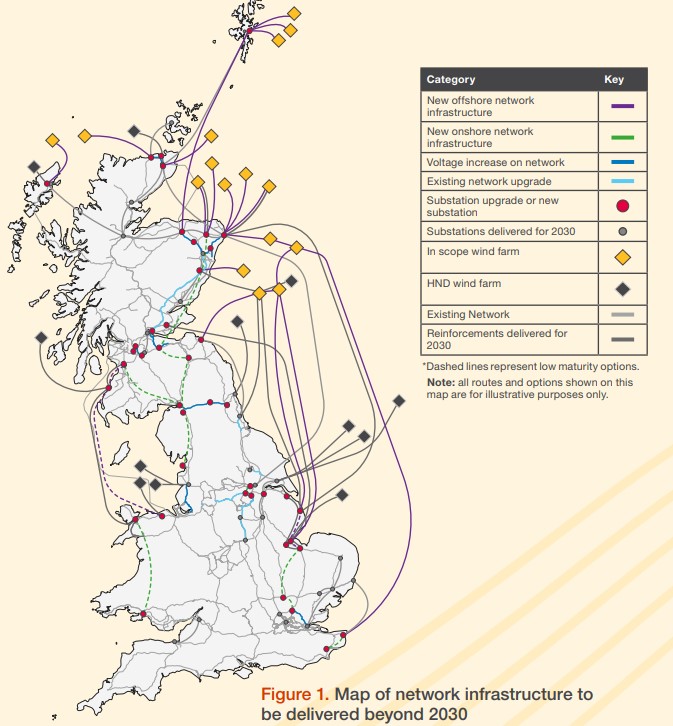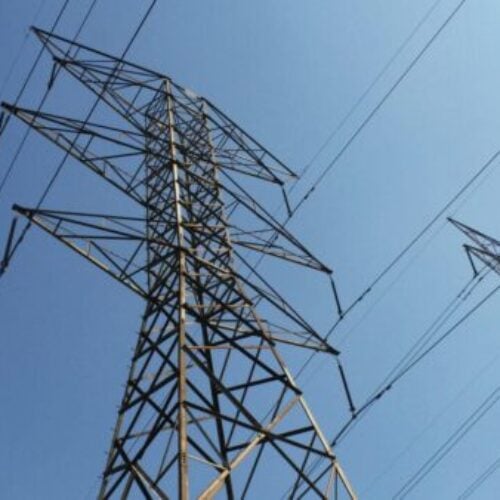National Grid ESO has proposed a £58 billion investment in the GB electricity grid to ensure it can meet the demands of being fully decarbonised by 2035.
Detailed within the organisation’s Beyond 2030 report, the investment plan would facilitate the connection of an extra 21GW of offshore wind, taking the nation’s total to 86GW, alongside several smaller, low-carbon generation assets dotted around the country.
Scaling investment in the GB electricity system will be critical for the energy transition. With electrification continuing to surge in the mobility and heating sectors, the grid must be modernised to maintain net zero targets. The ESO predicts that electricity needs are set to increase by up to 65% by 2035.
ESO likened the modernisation of the grid required to the building of the “super grid” in the 1950s and stated that to achieve this, a “countrywide effort” over the next decade is needed to upgrade the network in a “coordinated manner to minimise the impact”.
One bottleneck highlighted within the report is wind curtailment, a topic recently covered on Current±. ESO stated that, under the current system, ESO pays generators to switch off to prevent grid overload when there is too much generation that the grid can handle.
This prevents deeper decarbonisation of the electricity grid and further shows why further investment is required. But it also presents an opportunity for energy storage technologies.
Instead of the need to curtail wind resources, if sufficient energy storage is connected to the grid, this energy could be released instead of firing up gas power plants. Additionally, wind that is curtailed could be used to charge batteries. The result would mean a minimal impact on energy bills to consumers and deeper decarbonisation of the grid.
The design of the grid
ESO expressed the need for collaboration and has implemented this through a network assessment with GB’s Transmission Owners (TOs). The design would see over three times as much undersea cabling laid compared with new onshore routes, linking electricity produced in the seas around the shores onto the mainland at appropriate points.

There will also be a need to boost reinforcement of the grid from North East Scotland to North West England to ensure that power transfer between the North and South can be undertaken. The ESO explained that this could form a new arterial transmission route.
Enhancing capacity between the West and East coasts of England will ensure that primary arterial routes are strengthened.
Despite the need to scale network infrastructure, ESO highlighted that it must be developed “in the right place, at the right time, whilst also considering its impact on communities and the environment”. ESO argued that the proposed network design balances these needs.
The plan could also provide a £15 billion boost to the UK economy and support over 20,000 jobs yearly. The report said 90% of these would be located outside London and the South East.
Strategic demand key to ESO’s recommendations
Pivotal in developing the GB grid are new solutions, mainly via engineers. The system must be designed securely, ensuring it is resilient and affordable, negating the need for more network infrastructure in some circumstances. This could use possible existing infrastructure and route corridors.
Hydrogen is one solution referenced in the report, with ESO stating that it has identified regions of “strategic importance where large-scale demand users could be located”. Doing so would mean that building additional network infrastructure could be mitigated.
ESO’s planning processes already assume a 5GW increase in demand in Scotland as the energy landscape evolves between now and the mid-2030s.
In addition to this assumption, the organisation’s analysis shows that locating up to 5GW of flexible demand (a 10GW demand increase in total) behind bottlenecks on the network could save consumers £5 billion and may avoid the need for some network reinforcements, such as additional subsea circuits from Scotland to England or Wales and the associated infrastructure this could bring.
Need for a strategic, flexible energy system
Another aspect of the energy system ESO highlighted is its need to be strategic and flexible to cater to GB’s rising energy needs. These will vary between faster network delivery spearheaded by competition, creating a spatial energy plan directing the optimal locations of generation and demand assets, and potential reforms to the wholesale electricity market.
According to the ESO, this recommended electricity network design facilitates the connection of ScotWind and enables the government to meet its decarbonisation target. However, to realise these benefits, network infrastructure development must be sped up in line with the actions set out in the government’s Transmission Accelerated Action Plan.
New grid plan deemed ‘essential’ to unlock economic growth
Due to the magnitude of the report, the energy industry has weighed in on its contents, with many in favour of the proposed developments.
According to RenewableUK director of future electricity systems Barnaby Wharton, one of the key takeaways is that it is “essential that we don’t delay any further and get on with the job”.
“Reinforcing and expanding our electricity grid is long overdue. It’s essential that we don’t delay any longer and get on with the job, to ensure that we can get the vast quantities of clean power we’re generating from offshore wind to British homes and businesses as efficiently as possible. This investment in new networks is absolutely vital, to slash bills, make our economy more competitive and boost Britain’s energy security,” Wharton said.
“The measures set out in this ambitious plan put offshore wind at the heart of our future energy system, enabling us to decarbonise our electricity network by 2035 and securing our position as a global leader in this key technology.
“This report shows that building vital new grid will create 20,000 new jobs and boost our economy by £15 billion a year in parts of the country which need regeneration. It also highlights the fact that local communities will have a strong voice in the wide-ranging consultations which will determine how these plans are delivered in a way which minimises environmental impacts, and that local benefit funds will be set up to recognise communities hosting new grid.”
Jess Ralston, energy analyst at the Energy and Climate Intelligence Unit (ECIU), reaffirms Wharton’s belief stating that the “UK simply hasn’t invested enough” in the grid to support net zero whilst adding that upgrading the power grid would boost energy security.
“The UK’s gas bill has topped £100 billion since the price started spiking more than two years ago with tax and billpayers alike having to fork out to cover it,” Ralston said.
“That’s £75 billion more than normal and that’s because the UK simply hasn’t invested enough in measures like insulating homes and upgrading the power grid that would have made us less dependent on international gas markets.
“Oil and gas prices are volatile and that won’t change. The Office for Budget Responsibility has modelled a scenario in which energy prices rise again, by 75% in 2025. By reinforcing the grid, we can use more British energy from renewables which will give the UK much greater energy independence as the output of the North Sea inevitably declines.”






